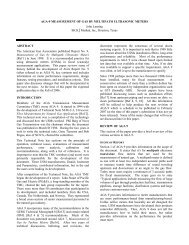FUNDAMENTALS OF ORIFICE METERING
FUNDAMENTALS OF ORIFICE METERING
FUNDAMENTALS OF ORIFICE METERING
You also want an ePaper? Increase the reach of your titles
YUMPU automatically turns print PDFs into web optimized ePapers that Google loves.
SEGMENTAL<br />
BORE<br />
Figure 9<br />
Quadrant Radius Orifice Plates<br />
Quadrant radius orifices are recommended for<br />
measurement of viscous fluids which have pipe<br />
Reynonds Numbers below 1 0,000. An increase in the<br />
viscosity of a fluid flowing through a sharp edge<br />
orifice will increase the diameter of the vena contracts,<br />
which results in a decrease in differential pressure.<br />
However, an increase in the viscosity of a fluid<br />
flowing through a flow nozzle increases the friction<br />
drop in the flow through the nozzle, which results in an<br />
increase in the differential.<br />
The quadrant radius orifice plate combines these two effects<br />
to produce a constant coefficient.<br />
SECONDARY EQUIPMENT<br />
The secondary equipment consists of a bellows type<br />
recorder (figure 1 0) or flow computer (figure 1 1).<br />
The recorder senses the static pressure, differential<br />
pressure<br />
Figure 10<br />
0<br />
QUADRANT RADIUS<br />
BORE<br />
and temperature and records the information on a circular<br />
chart. The chart is removed and taken to a remote location to<br />
be integrated. This determines the average of the charted<br />
variables over the time period indicated on the chart. The<br />
results, along with the physical characteristics of the fluid,<br />
are used to calculate the total flow rate over the charted<br />
period. This method of recording and integration has been<br />
the dominant method of determining flow rates for many<br />
years.<br />
Electronic flow measurement (EFM) is rapidly<br />
becoming the preferred method of data accumulation<br />
and volume calculation. The electronic flow computer<br />
is often used in conjunction with the flow recorder as<br />
shown above. The advantage in using flow computers<br />
is that they provide precise, real time measurements<br />
and / or computations. The flow computer senses the<br />
variables (pressure, differential, and temperature) and<br />
utilizes transducers to convert these variables to<br />
electronic data. The computer then performs the<br />
appropriate flow computations as stores the data until<br />
it is retrieved.<br />
EFM measurement is generally considered to provide<br />
more accurate and efficient flow computations.<br />
SUMMARY<br />
Figure I 1<br />
The wide variety of applications available today demands<br />
dependable, accurate measurement. Recently, significant<br />
improvements in metering standards and secondary<br />
equipment have enhanced the overall quality and efficiency<br />
of orifice metering. Given the proper design considerations,<br />
orifice metering satisfies the measurement requirements for<br />
a variety of applications.




